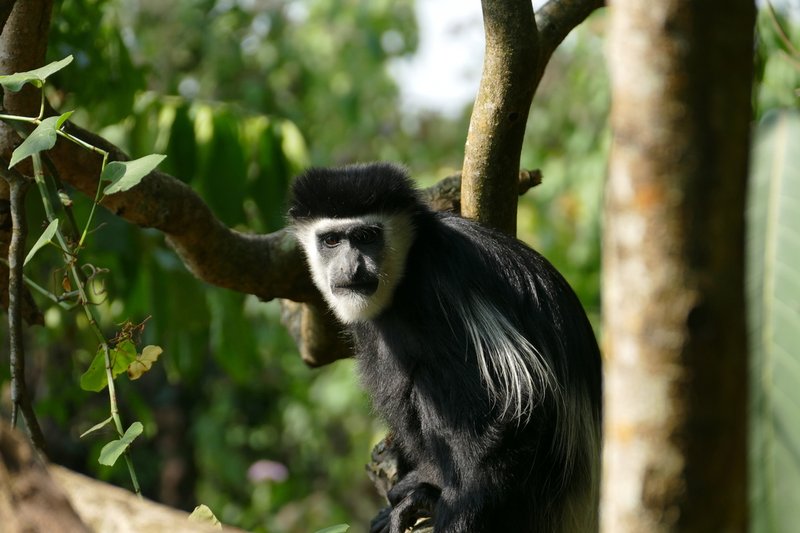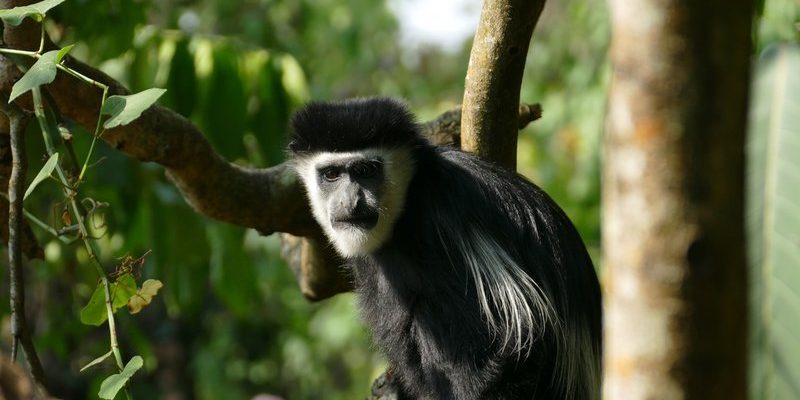
The Guereza, also known as the black-and-white colobus monkey, is one of nature’s most strikingly beautiful primates. With its long, flowing fur and acrobatic skills, this intriguing creature captures the imagination of anyone who encounters it. These monkeys thrive in the lush forests of Africa, and their lively social structures only add to their charm. Imagine a little monkey swinging effortlessly through the trees, showcasing its unique black-and-white coat like a fashion statement in the wild.
You might be wondering what makes the Guereza so special beyond its looks. Well, these monkeys are not just cute; they play vital roles in their ecosystems. By dining on leaves and fruits, they help maintain the health of their habitats. If you ever find yourself hiking through African rainforests, the Guereza’s distinctive calls often accompany your journey, reminding you that there’s much more to these woods than meets the eye.
Physical Characteristics of the Guereza
The Guereza is easily recognizable due to its distinctive appearance. They typically feature a striking black fur coat with white accents on their faces, tails, and limbs. An adult Guereza can weigh between 15 to 25 pounds, depending on gender and age. The males tend to be larger, sporting impressive manes that make them look almost regal. Imagine a lion, but in monkey form—this visual captures their majestic look perfectly.
One of the most fascinating features of the Guereza is its long, prehensile tail. This tail is not just for show; it acts as an extra limb, assisting them in balance and maneuverability as they leap from branch to branch. Their strong limbs and flexible joints allow them to make impressive jumps, sometimes spanning distances of up to 30 feet. It’s as if they’re in a constant game of leapfrog, showcasing their physical prowess.
Habitat and Range
The Guereza resides primarily in tropical rainforests, but you can also find them in moist savannas and mountain forests across Central and East Africa. Their habitat spans from Nigeria to Uganda, and they are often spotted in regions where tall trees provide ample cover. These monkeys prefer environments that offer plenty of foliage for foraging, making the lush, green canopies their perfect home.
But wait—what happens to the Guereza if their habitat is threatened? Deforestation and habitat loss due to human activities pose significant challenges for the survival of this species. As we encroach on their territory, these clever monkeys face difficulty finding food and shelter. It’s heartbreaking to think that such fascinating creatures could become victims of our expanding urban landscapes.
Diet and Eating Habits
When it comes to food, the Guereza is a herbivore, primarily feeding on leaves, fruits, and flowers. But don’t be fooled—these monkeys are picky eaters! They have a preference for young, tender leaves that are easier to digest, and their diet may vary by season, depending on what is available. This seasonal variability is vital for their health and survival.
The Guereza’s digestive system is uniquely adapted to break down tough plant materials. Their stomachs are quite large, allowing them to ferment the leaves they consume, maximizing nutrient extraction. Think of it like a gourmet chef making the most of every ingredient in their kitchen; the Guereza makes sure to get every ounce of potential from its leafy meals.
Social Structure and Behavior
Guerezas are highly social animals and live in groups called troops, which can range from a few individuals to over a dozen. These troops usually consist of a few males and several females, along with their offspring. This social structure enhances their ability to defend against predators and share resources. The camaraderie among group members is heartwarming to observe—like a close-knit family gathering, complete with playful interactions and social grooming.
One of the most intriguing aspects of their behavior is their communication style. Guerezas use a combination of vocalizations, facial expressions, and body language to convey messages. Their calls can be loud and distinctive, often echoing through the forest. Picture a lively conversation among friends, where each exchange has its own unique flair. Their vocal repertoire is essential for alerting each other about potential dangers and maintaining social bonds within the troop.
Reproduction and Lifespan
The Guereza has a fascinating reproductive cycle. Mating typically occurs throughout the year, with a gestation period of around six months. When a female Guereza gives birth, she usually has a single offspring, though twins can occur on rare occasions. The newborns are adorable, often clinging to their mothers for safety and warmth, much like a toddler holding onto their parent during a crowded event.
Young Guerezas are dependent on their mothers for the first few months of life but soon become more adventurous, exploring their surroundings and learning the ropes of their social structure. In the wild, Guerezas can live up to 20 years, though that number can vary based on environmental pressures and predation.
Conservation Status
Sadly, the Guereza is facing threats, primarily due to habitat destruction and hunting. Many forest areas are being cleared for agriculture, which reduces their living spaces significantly. Conservation efforts are crucial for preserving their populations. Organizations work tirelessly to protect these magnificent creatures and their habitats, often collaborating with local communities to promote sustainable practices.
Every little bit counts! By supporting eco-tourism and conservation initiatives, you can play a part in helping the Guereza thrive. Imagine being part of a community that actively works to ensure that future generations can enjoy watching these incredible monkeys swing through the trees as they have for millennia.
Interesting Facts About Guereza
| Common Name: | Guereza |
| Scientific Name: | Colobus guereza |
| Size: | 15-25 pounds |
| Habitat: | Tropical rainforests, moist savannas |
| Diet: | Leaves, fruits, flowers |
| Lifespan: | Up to 20 years |
| Social Structure: | Troops of a few to over a dozen |
| Conservation Status: | Vulnerable |
FAQ
What is the Guereza’s natural habitat?
The Guereza primarily dwells in tropical rainforests and moist savannas across Central and East Africa. They thrive in areas with abundant trees that offer both food and shelter. Their choice of habitat is crucial as it allows them to forage efficiently and avoid predators.
Are Guerezas endangered?
The Guereza is classified as ‘Vulnerable’ due to threats like habitat loss and hunting. Conservation efforts are in place to protect their populations and habitats. Local initiatives and sustainable practices can help ensure their survival amid growing environmental pressures.
What do Guerezas eat?
Guerezas are herbivores and primarily feed on leaves, fruits, and flowers. Their diet varies seasonally, and they tend to prefer young, tender leaves that are easier to digest. This selective feeding helps them maintain a healthy gut and obtain vital nutrients from their food sources.
How long do baby Guerezas stay with their mothers?
Young Guerezas stay with their mothers for several months after birth. Initially, they rely on their mothers for nutrition and protection, but as they grow, they become more independent, exploring their surroundings and interacting with other troop members.
How do Guerezas communicate?
Guerezas communicate using a mix of vocalizations, facial expressions, and body language. Their distinctive calls can be loud and carry over long distances, helping them alert their troop to potential dangers while also maintaining social bonds.
What are the main threats to the Guereza?
The primary threats to the Guereza include habitat destruction due to deforestation and agricultural expansion, along with hunting in some areas. These pressures can lead to population declines and emphasize the need for conservation efforts in their native habitats.
Is it possible to see Guerezas in the wild?
Yes, you can see Guerezas in the wild, particularly in protected areas and national parks across their range in East and Central Africa. Wildlife tours and eco-tourism can provide opportunities to observe these incredible monkeys in their natural habitat while supporting conservation initiatives.
How do Guerezas adapt to their environment?
Guerezas have adapted to their environment through their specialized diet and impressive physical abilities. Their long tails help them maintain balance while navigating the trees, and their digestive system is tailored to process tough plant material, allowing them to thrive in their leafy forest homes.
Do Guerezas have predators?
Yes, Guerezas do have natural predators, including large birds of prey and snakes. By living in social groups and using their vocalizations to alert each other to danger, they enhance their survival chances against these threats.
Can Guerezas be kept as pets?
Keeping Guerezas as pets is generally not advisable due to their complex social needs and specialized diets. They thrive in the wild and play specific roles in their ecosystems that cannot be replicated in a home environment.
How can I help protect Guerezas?
You can support Guereza conservation by spreading awareness about their plight, participating in eco-friendly tourism, and supporting organizations that focus on wildlife protection. Every small action can make a difference in ensuring that future generations can enjoy the beauty of these monkeys.

